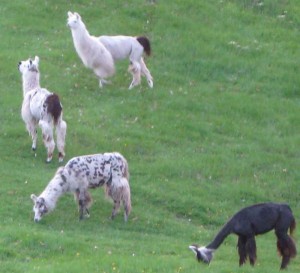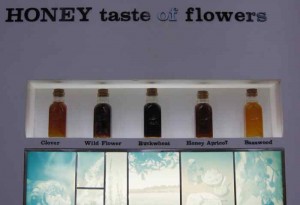Serious honey production in Wisconsin began in the mid 1800’s, a short time after the state opened up to settlement. While there were some settlers in the early 1800’s, disputes over territory by the native Indians made life uneasy for them. This situation escalated until the Black Hawk war in 1832 ended the dispute and opened the territory to settlement. For an insightful account of the Indian version of events and their traditions, I recommend reading the autobiography of Black Hawk, chief of the Sacs, dictated by him and faithfully translated for posterity.
Honey bees had settled in Wisconsin in the 1820s on their own migration across the continent from the east. Unlike their human counterparts, bees were welcomed by the Indians who quickly discovered their sweet treasure. They became proficient in finding honey, as was determined by settlers who found ladders and bee trees cut by the Indians. Black Hawk too, refers to cutting down bee trees in his autobiography.
Bees thrived in Wisconsin because of the natural openings between forest and open land where they could find hollow trees for hives and extended blossoming seasons of non-forest plants. In Wisconsin this was commonly found between prairie and forest and in natural “Oak Openings.” Also many surviving trees on the prairie lands (kept open by frequent burnings by the Indians) were hollow.
By the mid 1800’s the state of Wisconsin was likely the largest source of wild honey outside of New England. Locations of bee trees were noted by W. A. Schorger 1967/68 The wild honeybee in early Wisconsin mainly in Southern Wisconsin.
Wisconsin is an agricultural state well known for beer and dairy products, but is also home to more exotic farm animals. And in 2010 it ranked eighth in honey production in U.S. Welcome to the land of “milk and honey.”
By 1850 over 300,000 people had settled in Wisconsin. Many settled in, or arrived through Milwaukee. Most came from the Eastern United States, but almost a third were from other countries, primarily Irish, Germans, Norwegians and French Canadians. Other ethnic groups of note that settled in SE Wisconsin include the Danes in Racine county, and the Italians in Kenosha county.
Honey production grew dramatically as it transitioned from wild honey hunting of bee trees to bee farming in the late 1800s. The growth was fueled partly by the familiarity with beekeeping by European farmers who settled there, and partly from the rarity of sugar, but mainly from innovations in beekeeping. Early on beekeepers made hives by cutting out the section of the bee tree with the hive and locating it close to the farm. These early hives were called “Bee Gums or Log Gums.” These were replaced later with straw hives or “skeps.” But it was movable frame hives, patented in 1851 by Lorenzo Langstroth, later to become known as the father of beekeeping, that fueled the incredible growth in beekeeping in the late 1800’s. This allowed extraction of the honey without destroying the bees and the brood.
At the turn of the 20th century, the most important types of honey plants in Wisconsin were dandelion, clover, basswood, sweet clover, fireweed or Willowherb (Chamerion angustifolium), buckwheat, goldenrod, spanish needle (Bidens pilosa) and asters. Even with the reduction of forests and change of crops, many of these plants still produce production levels of honey today.
Honey Acres Honey & Museum
All most all of the historical beekeeping enterprises are gone, although some in existence today were built upon the successes and knowledge of these early beekeeping pioneers. And there is one that can actually trace its family ownership back to the mid 1800’s—Honey Acres Inc., home of the Honey Acres Museum. Unique in Wisconsin, this museum is actually housed in the honey production plant on a working apiary.
It is located 2 miles north of Ashippun, Wisconsin in Dodge County. It was begun 5 generations ago in 1852 by Christian Friederich Diehnelt. Christian brought his beekeeping skills from Rosswein, Germany. He purchased 7 1/2 acres (or 12 according to some sources) in what is now Milwaukee and started keeping bees. He began selling honey to the people in the area and eventually grew a substantial beekeeping and honey processing business. The city so well known for beer was also known for honey. The business moved to Ashippun in 1978 where it stands today.
As you approach the entrance you will notice the straw hives in small alcoves along the outside wall. The alcoves are called bee boles, built to protect the straw hives, called skeps, used for hundred of years by beekeepers in the UK and Europe.
The museum has a retail outlet located at the bottom of the striking six sided tower (shaped like a honeycomb cell). The fist thing you see when you enter is a row of five types of honey with a spigot below each—Clover, Wild Flower, Buckwheat, Honey Apricot (a flavored honey) and Basswood; representing many of the major honeys of Wisconsin. Spoons are provided so you can taste them all. Although I am partial to the stronger tasting basswood and buckwheat, the wild flower was my favorite.
The museum is well worth the trip! It is small but well organized. You can easily spend an hour if you take the time to look around. Inside are beekeeping artifacts, examples of hives from all over the world, Egyptian bee hieroglyphics, a slide show and, perhaps the most interesting, a live bee hive with glass sides and a microphone so you can see and hear the bees at work.
Walter Diehnelt, CEO of Honey Acres, is interviewed by Milwaukee Public Television’s Mondy Carter who gets bitten by the honey bug (the segment is 12 minutes long).
Honey Acres, Inc.
Honey Acres, Inc
PO Box 346
N1557 Highway 67
Ashippun, Wisconsin 53003
Phone: 1-800-558-7745
—————————————————–
References, Further Reading
The world history of beekeeping and honey hunting By Eva Crane
The wild honeybee in early Wisconsin by W. Schorger (1967/68) (see excerpt from the State of Wisconsin Collection)
The oak-openings or the bee hunter by J. Fenimore Cooper (1789 – 1851) Published 1871 (see digital archive)
Beekeeping in Wisconsin, By Lloyd Victor France, Thesis Submitted to the University of Wisconsin, 1915
Wisconsin Honey Producers Association
The honey bee is the Wisconsin State Insect.
Beelining and Bee Gums – Old Settlers Gazette 2006 (pdf)
Historic Images From the Wisconsin Honey Producer’s Association (1875 – 1979)







Recent Comments